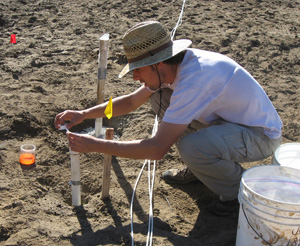An infiltration pond in California's Pajaro Valley has become a laboratory where scientists are working to improve techniques for recharging the region's depleted aquifer. Researchers at the University of California, Santa Cruz, presented their latest findings on water infiltration rates and water quality at the American Geophysical Union meeting in San Francisco on December 15.
"It's a partially natural laboratory where we can measure what factors influence the infiltration rates and impacts on water quality within the aquifer below," said Andrew Fisher, professor of Earth and planetary sciences at UC Santa Cruz and a member of a technical advisory committee for the Pajaro Valley Water Management District.
The pond is part of the district's Harkins Slough Project, an effort to reclaim runoff water from the slough and use it to replenish the valley's groundwater supply. Groundwater provides more than 90 percent of the water used by residents, farmers, and businesses in the Pajaro Valley, but water levels in regional aquifers have dropped over the past three decades. According to Fisher, the aquifer could suffer irreparable damage due to saltwater intrusion if usage at current rates continues without an increase in recharge rates.
Fisher has been studying the valley's hydrology for over 10 years. Since 2007, his research team has deployed an arsenal of specialized instruments on the bottom of the 7.5-acre pond to measure infiltration rates and trace water movement patterns as they change over time. Andrew Racz, a UCSC graduate student working with Fisher, will present an analysis of data collected over several years at the AGU conference.
"We're learning that there is a lot of variability within the pond," Racz said. "Some of what we are finding is a little counterintuitive."
Although the soil seems very uniform, he said, there are subtle variations in texture throughout the pond that cause the water to infiltrate through the base of the pond at different rates. In addition, there are large changes in infiltration rates over time. Clogging, either from sediments that wash in from the slough or microorganisms that grow in the soil, could be responsible for this variability, Racz said.
The researchers are also interested in measuring how water quality changes in the pond over time. Nitrate from fertilizers and septic systems can contaminate groundwater if it is not removed during the recharge process. Calla Schmidt, another graduate student in Fisher's team, tracks the levels of nitrate in the pond, shallow soil, and the aquifer below. She has determined that 50 percent of the nitrate in infiltrating water is removed through "denitrification," a process in which microbes in the soil consume nitrate and release nitrogen to the atmosphere (where nitrogen gas makes up most of the air we breathe).
"That rate is as good as what we see with other methods of denitrification, like constructing vegetative buffer strips around agricultural plots," Fisher said.
The water management district is following the work that Fisher's team is doing because of its practical applications for refining their aquifer recharge processes. But he says that the study has broader implications for understanding hydrological processes in general. The instruments the researchers are using allow them to measure and quantify how water moves and changes in the soil in unprecedented detail.
"People understand these processes conceptually, but we're trying to put hard numbers on them," Fisher said.



